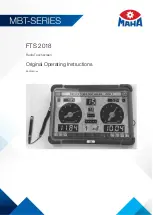
Music Lab Installation
Room Preparation
When preparing a music teaching lab, there are many factors to consider. For example, the size and shape of the room,
the availability of lighting and power outlets, as well as a room’s ventilation and temperature control need to be
addressed. Please consider the following physical and electrical requirements before installing your music teaching lab.
Physical Space Requirements
•
Make sure there is sufficient space for all musical instruments, hardware, benches, and students. Full-size, free-
standing keyboards (88-keys) require 22 square feet (including a bench and space for the student.) “Slab” key-
boards (less than 88 keys) may require much less space.
•
Create an effective floor plan that ensures a clear “line-of-sight” from all student keyboards to the teacher. While
this is not always possible due to the constraints of a given room, it is a good ideal.
•
Include a large desk or table next to the teacher keyboard if possible. This provides the teacher easy access to the
communication console and/or the computer.
•
Be sure that there is adequate space behind the teacher station. This allows the teacher to move easily from the
teacher station to the student stations.
•
Shade music lab windows to regulate sunlight. Avoid bright or direct sunlight in the lab, because heat generated
by sunlight can overheat the Communication Console. Room temperature should not exceed 85 degrees during
normal use. The ideal physical space will allow for regulated temperature and humidity.
•
Use anti-static, or static-resistant, carpet on the floors whenever possible to lower the noise-level in your lab.
Electrical Requirements
•
Once the floor plan is defined, determine the number of electrical outlets and power strips needed to supply
power to all devices. Isolate the MTLC-16 Communication Console from devices such as computers or lights by
plugging the devices into separate 120v wall plug receptacles. Plugging computers or rheostatic lights into the
same receptacle as the MTLC-16 could cause disturbing noise and hum during operation. Use only the supplied
A/C power adapter; using other A/C adapters can damage the unit and void the warranty.
•
Use surge protectors on all electronic equipment in the music lab. This includes the MTLC-16 Lab Controller, the
teacher’s instrument and computer, the student keyboards, and all external audio devices. Check the voltage and
amperage requirements for the equipment being installed and consult with building engineering staff regarding
the level of required electrical service needed.
•
Set the main power switch of the Music Tutor Lab Controller to the “Off” or “Out” position before connecting the
A/C power adapter to a 120v wall plug receptacle. Use only the A/C power adapter supplied with the Music
Tutor Lab Controller; using other A/C adapters can damage the unit and void the warranty.
•
For further protection against electrical surge damage, disconnect all A/C power adapters from the wall plug
receptacle during school vacations or summer breaks.
Equipment Checklist
The MTLC-16 includes all of the components needed to connect up to (16) student instruments and (1) teacher instru-
ment. It also includes all of the software needed to control the communication console via computer, to provide visual-
ized learning tools, and to keep track of class rosters and grades. Before installing the MTLC-16, be sure you have the
following components:
Hardware
Music Lab Installation Guide
8
Содержание MTLC-16
Страница 47: ......
Страница 48: ...Roland Corporation U S 5100 S Eastern Avenue Los Angeles CA 90040 2936 www rolandus com 2944US...










































